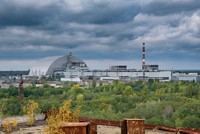Advertisement
Grab your lab coat. Let's get started
Welcome!
Welcome!
Create an account below to get 6 C&EN articles per month, receive newsletters and more - all free.
It seems this is your first time logging in online. Please enter the following information to continue.
As an ACS member you automatically get access to this site. All we need is few more details to create your reading experience.
Not you? Sign in with a different account.
Not you? Sign in with a different account.
ERROR 1
ERROR 1
ERROR 2
ERROR 2
ERROR 2
ERROR 2
ERROR 2
Password and Confirm password must match.
If you have an ACS member number, please enter it here so we can link this account to your membership. (optional)
ERROR 2
ACS values your privacy. By submitting your information, you are gaining access to C&EN and subscribing to our weekly newsletter. We use the information you provide to make your reading experience better, and we will never sell your data to third party members.
Nuclear Power
A decade after the nuclear incident, Japan plans to release contaminated water after treatment
by Bibiana Campos-Seijo
April 16, 2021
| A version of this story appeared in
Volume 99, Issue 14
Fukushima is in the news again. March 11, 2021, marked 10 years since the nuclear disaster at the Fukushima Daiichi Nuclear Power Plant in Ōkuma, Japan. But that is not the reason Fukushima is in the headlines. The Japanese government has decided to release treated radioactive water from the disaster into the ocean in 2 years. A lot of people are not happy.
In March 2011, the worst earthquake to ever hit Japan caused the worst nuclear accident in the country’s history. The 9.1-magnitude earthquake rocked the country for almost 6 min, moved the main island of Honshu 2.4 m east, and caused a tsunami that devastated the region and killed approximately 16,000 people. Another 2,500 were never found.
The tsunami also caused the Fukushima Daiichi plant to lose power that was needed to cool the reactors. The fuel rods began to melt and leaked radiation into the surrounding area. Cooling water was continuously pumped through the reactors to prevent further damage to their cores. Once used, this cooling water carries high concentrations of radioactive isotopes. Large amounts of this wastewater are stored on-site in purpose-built tanks of 1.37 million-metric-ton capacity.
The Japanese government plans to treat the water before release to remove most of the radioactive material and then dump it into the ocean. Japan’s neighbors, fishers in the region, and environmental groups oppose this plan.
The Chinese, South Korean, and Russian governments claim that there hasn’t been full consultation and that the decision could affect the safety of their citizens. South Korea’s leadership is evaluating taking Japan’s decision to an international court. The International Atomic Energy Agency, by contrast, supports Japan’s plans, stating that this type of controlled water release is “routinely used by operating nuclear power plants in the world.”
This situation reminds me of an incident that happened in Spain 55 years ago. The authorities needed to demonstrate that the site of a nuclear incident was safe, and they sent a minister and an ambassador to take a swim. Here’s what happened:
On Jan. 17, 1966, a US Air Force B-52G bomber was refueling midair off the coast of Spain. The bomber collided with and destroyed the fuel tanker, and the B-52G broke apart. Seven crew members died.
The B-52G was carrying four hydrogen bombs. Two were recovered intact. The other two crashed without setting off a nuclear explosion, but the impact activated the bombs’ conventional explosives, releasing a plutonium cloud that dispersed onto nearby farmland and residential areas. A 2.6 km2 area near the Spanish town of Palomares was contaminated.
The accident made the front pages of the New York Times and Washington Post as well as the majority of Spanish media. Angry protests and demonstrations by the locals and others followed. This was in the middle of the Cold War, and Spain was under Francisco Franco’s dictatorial regime. The cleanup operation was classified. To downplay the risk of contamination, Manuel Fraga Iribarne, who was the information and tourism minister, and Angier Biddle Duke, who was the US ambassador to Spain, swam—with press from all over the world as their witnesses—a mere 15 km away from where the bombs were recovered. The propaganda operation had the desired effect. It salvaged Spain’s tourism industry. Sadly, the area is still affected.
In 2009, Time magazine named the incident in Palomares one of the world’s “worst nuclear disasters.” As of 2016, about half a kilogram of plutonium—less than a microgram can cause cancer—still remained on the ground, according to the New York Times.
I understand the opposition to Japan’s plan. Fortunately, Japan’s prime minister shouldn’t need to take a dip for the public.
Views expressed on this page are those of the author and not necessarily those of ACS.



Join the conversation
Contact the reporter
Submit a Letter to the Editor for publication
Engage with us on Twitter